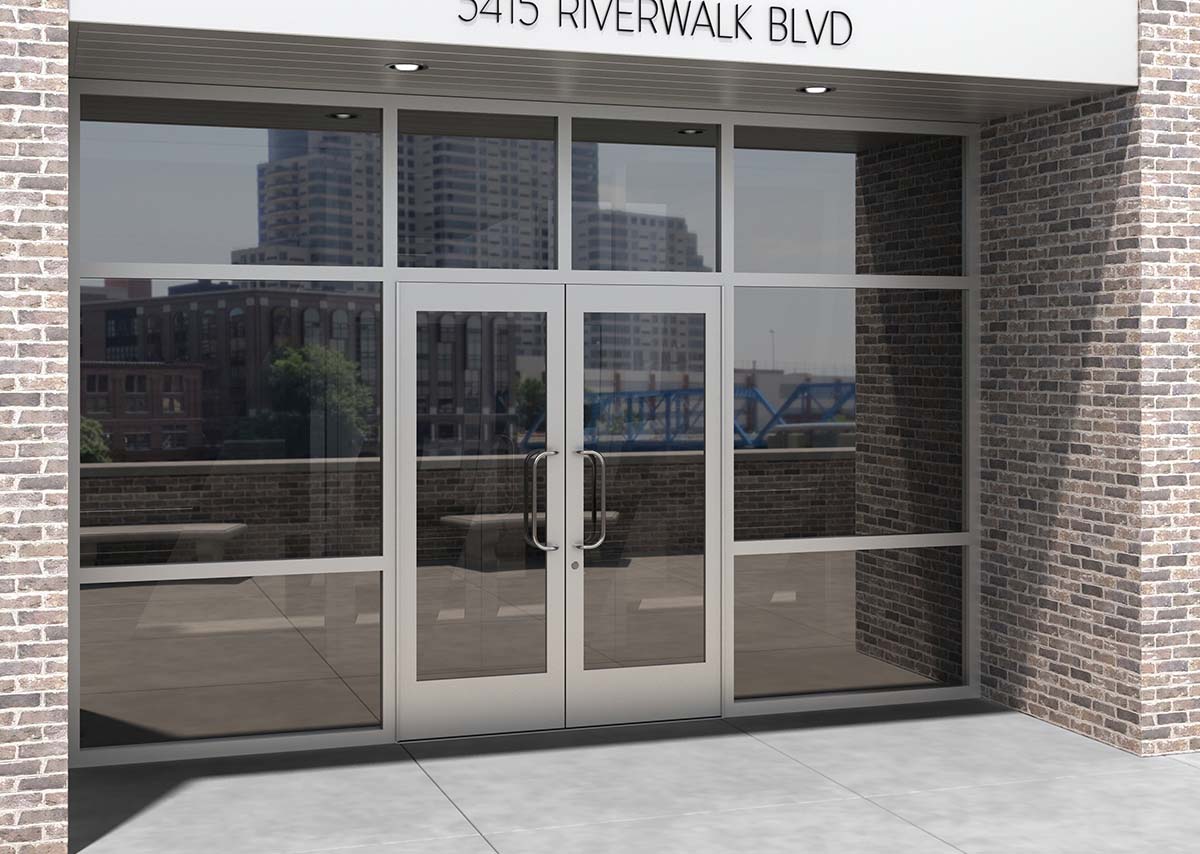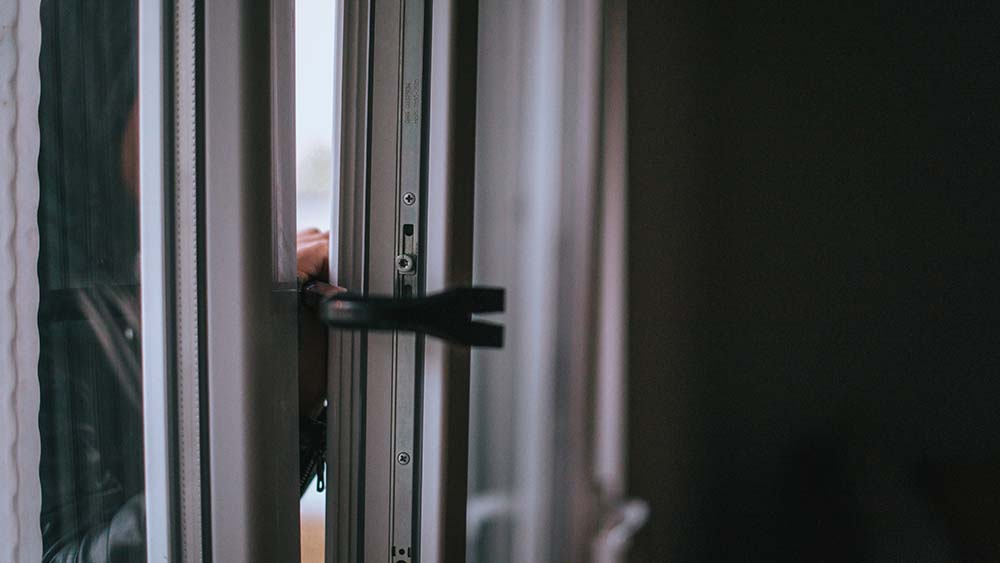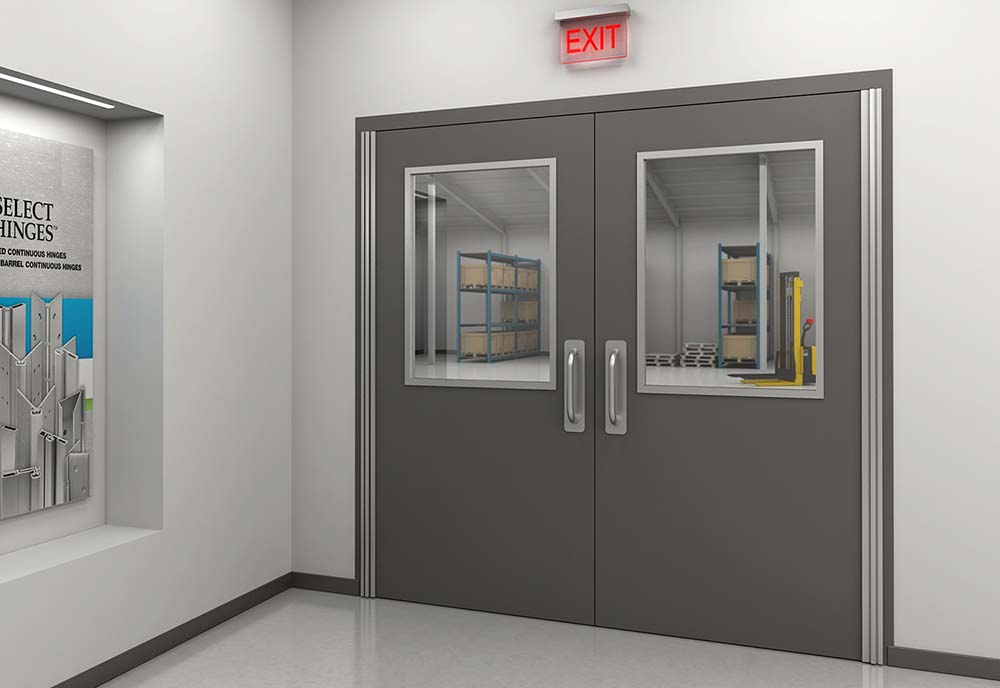
Choose the wrong hinge and you will be out more money and time on every door
ID high-abuse entrances | Weigh-in these factors | Use this scorecard to make the right hinge decision | Start saving time and money
Ever watch a high school football team go through the school’s back door to reach the practice field? Those young players don’t care about the door, its hinges or hardware. All they care about is getting outside as fast as they can, punishing anything in their path.
This is one of many examples of how doors experience high abuse in schools, restaurants, hospitals, hotels and more. Everyone entering or exiting your building or interior rooms isn’t thinking about the impact that hard pushes, forceful slams, banging carts or improperly propping doors open can have on your maintenance budget Specify the wrong hinges on high-abuse entryways and you will face ongoing door repairs and hinge replacements that will quickly devour any initial hinge cost savings. But you don’t have to keep losing money and maintenance time.
Three steps to help you choose the right heavy-duty hinge for your high-abuse applications.

1. Identify your building’s high-abuse entrances.
Start by doing a door traffic assessment.
High-traffic doors do not always equate to high-abuse doors and high-abuse doors do not always equate to high-traffic volumes, but this is a good first assessment of whether it’s an existing building or still in the blueprint phase. Determine whether low, medium or high traffic comes through the front, back or side exterior entrances. On average, how many people walk in and out of each of the interior rooms each day? How many people are in the hallways at various times? How often do they open and close the bathroom entrance and stall doors each day?
Observe the high abuse of your institutional doors.
Doors that see the highest abuse are typically in these institutional buildings:
- Schools: K-12 and higher education — colleges, universities and trade schools.
- Door locations: Front entrances, exterior side doors to the gymnasium, natatorium, auditorium or theater, parking lots, playgrounds and sports fields, and back doors to storage and cafeteria kitchens. Interior doors, especially to the gymnasium, cafeteria, information center, media center and parking garage entrances serve more students and staff weekly than individual classrooms. Bathroom entrances and individual stall doors also can see high abuse.
- Typical abuses: Older students shoving or kicking exterior doors open or maintenance staff propping open doors with broom handles and pushing garbage cans in and out. School staff moving media, technology and supply carts or delivering food, beverage and supplies with hand trucks and pallet jacks. Natatorium doors suffer abuse from pool chemicals and humidity.
As you pre-assess abuse levels, remember junior and senior high students typically are harder on doors than elementary or college-aged students and teachers.
- Healthcare facilities: Hospitals, clinics, labs, rehabilitation facilities, mental and behavioral health buildings.
- Door locations: Typically, front entrances use automatic sliding doors that require specialized hardware. Focus, instead, on the side, back exterior entrances and parking garage exits used by employees, delivery services and maintenance staff. Assess the abuse of interior doors, including patient rooms, libraries, labs, testing facilities, pharmacy, auditorium, cafeteria, conference rooms and restroom doors and stalls. Look also at the cross corridor doors (these are often fire rated).
- Typical abuses: Medical supply and monitor carts, hand trucks and pallet jacks, adding/removing furniture, wheelchairs and mobility equipment.
- Restaurants:
- Door locations: Front, side and back exterior doors, back-of-the-house interior doors and bathrooms.
- Typical abuses: Pallet jacks and hand trucks moving supplies, food and cleaning supply carts, wheelchairs, strollers and personal mobility equipment.
- Hospitality and entertainment facilities: Hotels, motels, lodges, convention centers, banquet and reception halls, stadiums, gaming facilities, theaters and concert halls.
- Door locations: Front, side and back exterior doors, front and back-of-the-house interior doors, interior guest and meeting room doors, and bathrooms.
- Typical abuses: Luggage and luggage carts, pallet jacks and hand trucks used to move supplies, garbage cans, cleaning carts and floor cleaning equipment, wheelchairs, strollers and other mobility equipment, water and cleaning products.
- Retail and office facilities:
- Door locations: Front, side and back exterior doors, front and back-of-the-house interior doors, interior office and meeting room doors, and bathrooms.
- Typical abuses: Sans luggage, similar to hospitality facilities.
- Municipal buildings: Government offices, public safety (police and fire) buildings, courthouses, water treatment facilities and maintenance buildings, and airports.
- Door locations: Front, side and back exterior doors, front and back-of-the-house interior doors, interior office and meeting room doors, bathrooms and mechanical rooms.
- Typical abuses: A wide range of employees and public clientele enter and exit the building and very few think about how they open or close the doors. They abuse them with delivery pallet jacks and hand trucks, moving furniture, cleaning carts and floor cleaning equipment, and bang them with wheelchairs, strollers and other mobility equipment. They splash them with water and cleaning products or use broom handles, boxes and garbage cans to prop fire-rated doors open.

2. Weigh in these factors before finalizing your hinge selection
- Climate and weather.
- Evaluate how climate and weather can affect opening and closing your exterior doors.
- Snow, ice and ice-melting chemicals can corrode pivot hinges installed at the base of the door and make the door difficult or impossible to operate.
- High-velocity winds and debris from tropical storms, hurricanes and tornadoes can damage or dislodge doors, butt and pivot hinges and hardware.
- Evaluate how climate and weather can affect opening and closing your exterior doors.
- Security
- Identify your door security threats. What steps must you take to prevent active shooters from entering your building? Stop staff or students from propping open exterior doors with objects, some of which can damage the frame or hinge. Identify exterior or interior doors that no longer latch or toilet stall doors that are out of alignment and cannot be closed securely.
- Access control
- More and more buildings, especially new construction, are adding access control and monitoring. Protecting the electric wires and accessing them when they need repair is a serious consideration. The less downtime, the better the security.
- NFPA, ADA, IBC and FBC building code compliance
- Do your doors, hinges and hardware need to meet state, federal or international accessibility codes, fire ratings, high-velocity hurricane zone or tornado zones?
3. Use this scorecard to choose the right hinge for your building’s high-abuse doors
Butt hinges do not lower costs on high-abuse exterior or interior doors
- Advantages
- Butt hinges feature a variety of design configurations and bearings that work with different door heights, widths, thicknesses, weights and door operation frequencies.
- Low initial cost.
- Disadvantages
- The pivot point is not continuous. You must use great care to align the pivot point to prevent binding and premature failure.
- The top hinge takes the most stress to keep the door aligned. Butt hinges can not distribute the weight equally, so the door opening often fails prematurely.
- Doors wider than four feet require installation of 5-inch, heavy-duty hinges which makes the cost more comparable to geared continuous hinges.
- Through-wire preps are available, but there are limited places where you can install them because of the hinge’s location. Wire-access butt hinges are very difficult to service. When the wire breaks or malfunctions, the best solution is to replace the entire hinge, adding to maintenance costs.
- Since the hinges do not cover the length of the door and frame, hitting the edge with furniture, carts, pallet jacks, wheelchairs and more will delaminate the wood, requiring more frequent repair or door replacement.
- Butt hinges on high-abuse, high-traffic doors typically require maintenance, repairs or replacement every 5 to 7 years.
Pivot hinges fail quickly on high-abuse exterior doors
- Advantages
- Low-to-mid initial cost.
- Pivots support the top, mid and bottom of the door. Often a popular choice, due to cost, on heavier, high-traffic, but low-abuse interior doors.
- Disadvantages
- The pivot point is not continuous. It requires care to align the pivot point to prevent binding and premature failure.
- Not advisable for exterior door installations in wintry weather or saltwater environments. The weight of the door rests on the bottom pivot where most of the environmental abuse occurs. Dirt and grime build-up, salt, ice, water puddling, rocks and ice melting chemicals make the hardware susceptible to corrosion. Expect high, long-term maintenance and replacement costs.
- The weight of the door rests on one point of the hinge — on the bottom pivot — so the door could sag.
- Because the hinge does not run the length of the frame, wood doors can warp with time. Adding warp-preventing multi-locking systems increases the cost. Wood door edges are more susceptible to delamination, too, when carts, furniture, hand trucks, etc. bang into them.
- Through wire access at the top pivot creates wire chase challenges. Accessing and servicing the wire on a pivot hinge is very difficult. The best solution is to replace the hinge when the wire breaks or malfunctions, adding to your long-term costs.
- Entryways with doors wider than four feet, common in high-abuse entryways, should install two intermediate pivots. This adds significant costs and makes it more difficult to align the pivot points.
SELECT geared continuous hinges solve most high-abuse door problems for decades
- Advantages
- Mid-price initial cost; longest-term savings. Calculate continuous hinge savings here.
- Fits nearly every door size, including oversize doors that are taller or wider than standard measurements.
- Very durable. The U.S.-made, SELECT geared continuous hinge has been tested to last over 25 million open/close cycles or 60 years of high-traffic/high-abuse use. Once installed, it’s unlikely that you will ever have to maintain it or replace it.
- Attaches to the entire length of the frame; protects door edges from damage caused by carts, furniture, pallet jacks, hand trucks and cleaning equipment. Prevents interior and exterior doors from delaminating. Eliminates overextension repairs or replacement, too.
- Excellent hinge for access control doors. The SELECT All Through Wire (ATW) prep eliminates the need to remove and reinstall the door to make wiring repairs or replacements. Takes five minutes or less.
- Customizable to match the demands of your high-abuse doors; you can add more fastener holes, rivet nuts or use longer screws to improve performance.
- Meets most state and international (IBC) exterior and interior door building codes. In February 2022, the Florida Department of Business and Professional Regulation submitted its product approval for seven SELECT exterior door components. The following concealed geared continuous hinges passed FBC high-velocity hurricane zone (HVHZ) testing to TAS 201, TAS 202 and TAS 203 (cyclic wind, pressure and impact) at a design pressure of +/- 65 psf. (7th Edition 2020). Read more.
- Highest-level ballistic-resistance certification by the U.S. Department of State. SELECT’s U.S.-made geared continuous hinge was put through rigorous security testing including high-powered rifle fire and assault with sledgehammers, wedges and other tools. The hinge and the door still functioned after the forced-entry attacks, protecting the people on the other side.
- Fire ratings are available for both geared continuous and pin and barrel continuous hinges. There is no need for a fire pin on the aluminum continuous hinge.
- Long warranty. SELECT hinge warranties range from 10 years to no time limit.
- Disadvantages
- Not suitable for all glass doors or extra heavy doors over 1,000 lbs.
- Warranty not applicable for doors wider than four feet.

Start saving money and time at your high-abuse entryways
Talk with your architect, construction manager or hardware distributor about ordering the best new or retrofit hinge for your building’s high-abuse exterior and interior doors. They will tell you that SELECT Hinges are proven to save maintenance and replacement costs for decades. Or contact your SELECT Hinges sales representative or SELECT Hinges customer service representative for advice in choosing the right hinge, prep and customizations, so high abuse is no longer a worry, even long after you retire.






